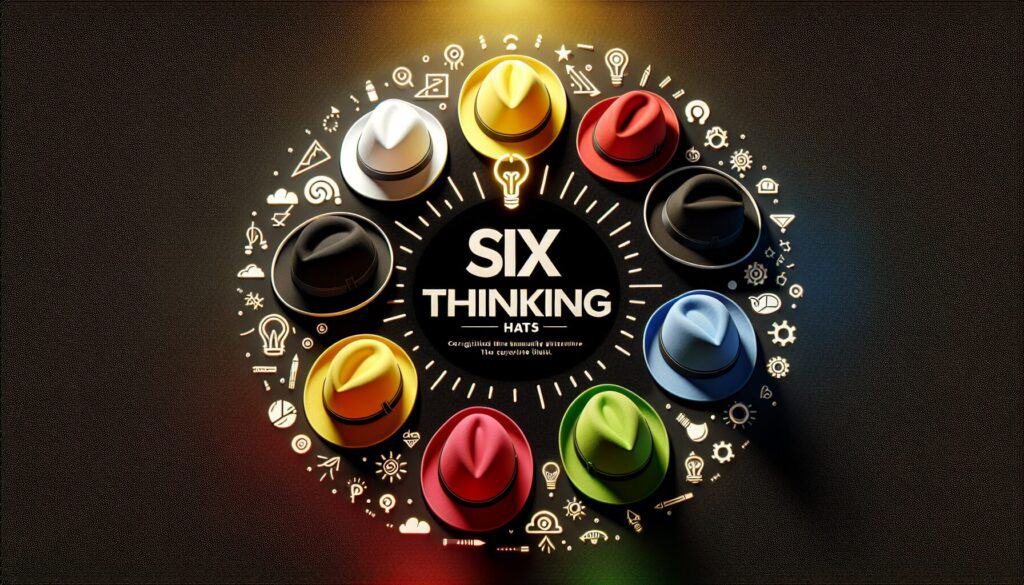A parallel thinking technique developed by Edward de Bono, designed to improve group discussions and decision-making by having participants look at an issue from six distinct perspectives, each represented by a colored “hat”.
- 方法: 工程, 质量
六顶思考帽

六顶思考帽
- 敏捷方法论, 集思广益, 创造力, 跨职能协作, 设计思维, 创新, 解决问题的技巧, 流程改进, 团队合作
目标
如何使用
- Participants metaphorically wear different colored hats: White (facts & information), Red (emotions & intuition), Black (caution & critical judgment), Yellow (optimism & benefits), Green (creativity & new ideas), and Blue (过程控制 & overview). The group focuses on one hat at a time.
优点
- Encourages thorough exploration of a topic from multiple viewpoints; Reduces conflict by separating ego from performance; Fosters focused and productive discussions; Promotes creative thinking and critical evaluation in a structured way.
缺点
- Can feel artificial or overly structured if not facilitated well; Requires discipline from participants to stick to the designated hat; May take time for teams to become proficient in its use.
类别
- 构思, 解决问题, 产品设计, 项目管理
最适合:
- Facilitating effective group discussions, exploring different perspectives on an issue systematically, and making more well-rounded decisions.
The Six Thinking Hats methodology can be employed in various industries, including product design, healthcare, education, and corporate strategy, allowing teams to tackle problems or innovate in a structured manner. This approach is particularly effective during brainstorming sessions, project reviews, and product development phases, where collaboration and comprehensive analysis are required. For example, in a design team developing a new consumer electronic device, members might use the White Hat to present market research data on user preferences, switch to the Red Hat to express feelings about design aesthetics, utilize the Black Hat to identify potential manufacturing limitations, and then adopt the Yellow Hat to envision the advantages this product could offer to customers. This technique is often initiated by team leaders or project managers, but it thrives on participation from diverse roles across an organization, including engineers, designers, marketers, and end-users. Its structured nature encourages all participants to contribute their viewpoints without falling into conflicts over personal opinions, as the focus transitions systematically from one aspect to another, fostering an atmosphere of respect and collaboration. Such meetings can lead to more innovative outcomes, as the Green Hat invites out-of-the-box thinking and the exploration of unconventional solutions. Companies that have successfully implemented this methodology report clearer decision-making processes, increased team alignment, and ultimately more robust product offerings that address various stakeholder needs.
该方法的关键步骤
- Introduce the issue to be discussed.
- Wear the White Hat: Focus on facts, data, and information relevant to the topic.
- Wear the Red Hat: Share emotions, intuitions, and gut feelings regarding the issue.
- Wear the Black Hat: Discuss potential risks, obstacles, and negative aspects.
- Wear the Yellow Hat: Explore benefits, advantages, and positive outcomes.
- Wear the Green Hat: Brainstorm creative solutions and new ideas.
- Wear the Blue Hat: Guide the process, summarize discussions, and outline next steps.
专业提示
- Rotate the hat order based on the phase of discussion, ensuring fresh perspectives emerge at critical stages.
- Assign specific roles to participants for each hat to enhance engagement and accountability during discussions.
- Document the outputs from each hat systematically to create a comprehensive record for future reference and analysis.
历史背景
1980
1980
1980
1986
1987
1990
1990
1972
1980
1980
1986
1986
1987-03
1990
1990
(如果日期不详或不相关,例如 "流体力学",则对其显著出现的时间作了四舍五入的估计)。















相关文章
METS 卡路里计算器
元分析
信息映射
心理模型图
可接受的最大推力和拉力
物料需求计划(MRP)